Brown wooden frame Wylex Standard fusebox
This type of fusebox has not been made for several decades. However many homes still have examples like this.
View of the assembled fusebox
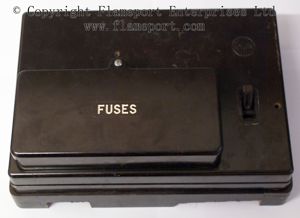 This shows the fusebox as it would appear when installed.
This shows the fusebox as it would appear when installed.
The front panel and fuse cover are made from heavy duty brown plastic. The fuse cover is secured with a single fixing screw, and the main switch can be seen to the right of the fuse cover.
Partially dismantled 1
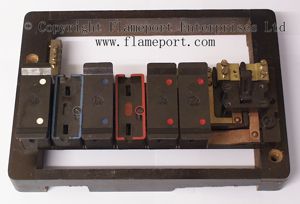 Here, the front panel and fuse cover have been removed.
Here, the front panel and fuse cover have been removed.
Some of the fuses have been removed to show the plastic shields behind. The wooden frame is clearly visible, and note that there is no back to the fusebox.
Partially dismantled 2
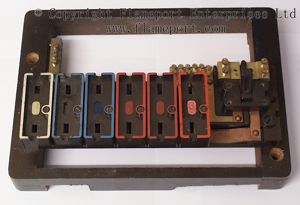 All fuses and front covers removed. The Earth bar is at the top left, and the Neutral bar can be seen immediately above the first fuse position, next to the main switch.
All fuses and front covers removed. The Earth bar is at the top left, and the Neutral bar can be seen immediately above the first fuse position, next to the main switch.
When new, this was considered a large fusebox. Smaller houses would have 3 or 4 fuses only - sockets, lights and cooker.
Note that the holes in each shield are different sizes. Larger rating shields have longer slots, to prevent larger fuses being inserted into smaller rated shields.
Fully dismantled
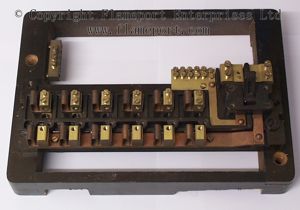 In this photograph, all of the fuses, carriers and covers have been removed. The live and neutral supply is connected to the terminals at the top right (neutral on the left, live on the right). The live busbar can be seen along the bottom of the fuse carrier positions.
In this photograph, all of the fuses, carriers and covers have been removed. The live and neutral supply is connected to the terminals at the top right (neutral on the left, live on the right). The live busbar can be seen along the bottom of the fuse carrier positions.
The frame of the box is wood, and has two large fixing holes to secure it to the wall. Typically, these boxes would be mounted onto a plywood panel, so when installed, the back of the box was also wood.
The neutral bar has 6 terminals, one for each of the fuseways. Note that the Earth bar (top left) only has 4 terminals. This is because when this type of box was in common use, lighting circuits typically did not have any earth connections.
Rear view
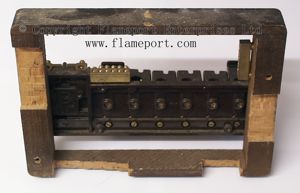 This shows the back of the fusebox. The cutout sections are where wiring would have entered.
This shows the back of the fusebox. The cutout sections are where wiring would have entered.
You can see the chisel marks where the wood has been cut away.
Fuse and carrier detail
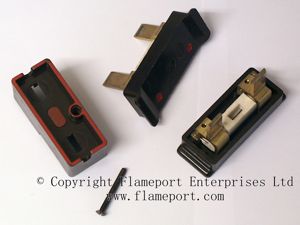 The plastic shield is secured with a single screw. These are rewireable fuses, the wire passes through the central white ceramic section and is secured to the brass terminals at each end.
The plastic shield is secured with a single screw. These are rewireable fuses, the wire passes through the central white ceramic section and is secured to the brass terminals at each end.
The plastic shield shown here is a very old type. These are all made from brown plastic with a painted edge to indicate the rating (red in this case). Newer types were moulded from coloured plastic.
The fuses have two coloured spots to indicate the rating. Red being 30A. Other types were 5A White, 15A Blue, 20A Yellow.
The coloured spots are actually holes where the terminal fixing screws are. Should the coloured filler fall out, live parts are exposed, creating a very dangerous situation.
Fusebox without fuses
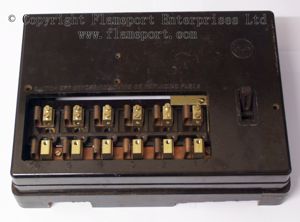 This shows the fusebox with all of the fuses removed. Although the front panel is still attached, this still presents a significant danger. When the main switch is ON, the lower row of terminals is live.
This shows the fusebox with all of the fuses removed. Although the front panel is still attached, this still presents a significant danger. When the main switch is ON, the lower row of terminals is live.
Without shields, all of the fuse positions are identical. Any rating could be fitted to any position, although it was usual to install higher ratings nearest to the main switch on the right.
Each fuse position is rated to a maximum of 30A, and the whole box to 60A. Although more recent 40A and 45A devices will physically fit, these must NOT be installed, as they will lead to overheating and damage.
Front panel and fuse cover
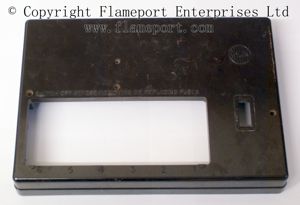
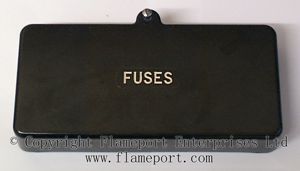 The front panel and the fuse cover. Note the extreme thickness of the plastic material - approximately 5mm or 1/4 inch. This is 10 times thicker than a typical modern consumer unit.
The front panel and the fuse cover. Note the extreme thickness of the plastic material - approximately 5mm or 1/4 inch. This is 10 times thicker than a typical modern consumer unit.
The front panel has a moulded Wylex logo at the top right. Each fuse position is numbered 1-6, with 1 nearest the main switch. The wording 'Switch off before removing or replacing fuses' is moulded into the plastic just above the fuse positions. This is because removing a fuse with the circuit live will cause sparking at the terminals. Inserting a fuse onto a faulty circuit will cause the fusewire to vaporise. The molten copper vapour sprays out of the top and bottom of the fuse, right where your fingers are holding it.


